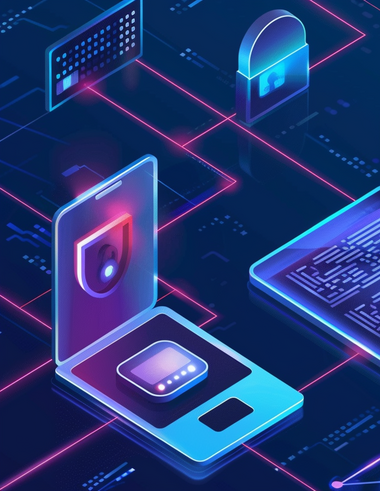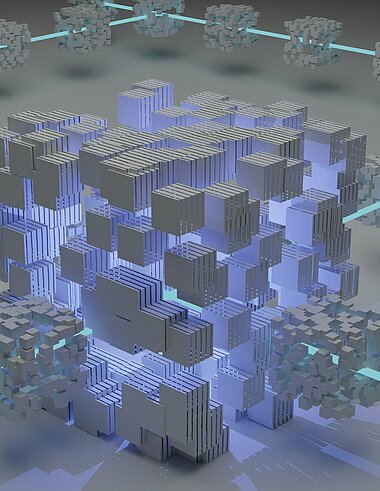How can emerging technologies like Artificial Intelligence (AI) and Blockchain both individually and collectively change, design, and shape the domains of trade, technology, sustainability and human rights? To find answers to these important questions and provide a platform for experts from both cutting edge tech fields to engage and discuss, HTW Berlin hosted its 9th Blockch[AI]n@HTW Conference in summer 2024. We caught up with co-host Prof. Dr.-Ing. Katarina Krüger (Professor at HTW Berlin) as well as speakers Izzat-Begum Rajan (Managing Partner Imani Partners) and Marleen Krüger (Partner WilmerHale) to find out more about the conference, the intersection between AI and Blockchain as well as the impact of the EU’s AI Act on the web3 and AI ecosystems.
What makes the Blockch[AI]n@HTW Conference so special and what was the highlight of the 9th edition for you personally?
Prof. Dr.-Ing. Katarina Krüger: The idea of a Blockch[AI]n@HTW Conference was born from the fact that I wanted to present the solutions developed in the lectures to a wider audience in collaboration with the students and the different facets of our use cases. I still want us not only to engage with the blockchain community, but also to bring in interested people from outside the field and enter into the dialogue. This has now been achieved brilliantly for the ninth time and the mix of participants with different backgrounds and expertise is what makes this conference format so appealing to me. What is also special for me as the initiator and host of the Blockchain@HTW conference is that we have great speakers from all over the world every year.
My personal highlight of this year's 9th Blockch[AI]n@HTW Conference is not a single presentation, but rather the great interdisciplinarity and the interest of all participants in the knowledge of each individual. This mutual respect and enjoyment of the discussions inspired me once again.
Izzat-Begum Rajan: The first thing that made it so special is because I was able to come back to one of my favourite cities in Europe, Berlin. Secondly, is of course, the fantastic crowd of experts, both on panels and attendees, that Prof Krüger managed to gather in one place for two days of exhilarating conversations, incredible ideas to be broken down into bite sizes and of course novel concepts being built during the more intimate workshops.
Marleen Krüger: The Blockch[AI]n@HTW Conference series is what all conferences should be, but very few are: a forum to exchange new ideas and discuss serious issues among a group of experts with very different backgrounds. The absolute highlight of the 9th edition for me was to debate the opportunities and challenges associated with the use of AI in a dispute resolution context with various experts in technology, law, and tax. Most notably, I attended a workshop focussing on ways in which AI can enhance access to justice in small states. The discussions during that workshop were a true exchange of ideas and have triggered further initiatives by the participants.
In your opinion, what is the connection between Web3 and AI?
Izzat-Begum Rajan: If one should make an analogy, I think that Web3 is the pipe (wrapper) and AI (or a form of it as it comes in many shapes and colours) one of the add-ons one can use to enhance some of the incredibly useful features of Web3. Look at Web3 as if it were the fastest German car ever built – the Gumpert Apollo – with a human driving the car or with an AI co-piloting the car with the human being.
Prof. Dr.-Ing. Katarina Krüger: In my opinion, it's worth looking closer at the definitions of both terms first. Broadly speaking, Web3 is an improved version of the existing internet that we all know and use. The improvement is that decentralised structures break the dominance of large technology companies such as Alphabet (Google), Amazon, Apple, Meta (Facebook), Tencent, Alibaba, Bytedance etc. and create an egalitarian internet in which users who also generate data are rewarded for generating the data. In this context, data is, for example, our surfing behaviour on the internet, from which companies create targeted user profiles and make us offers based on our user behaviour, etc. Data protection and data security are guaranteed via blockchain technology or distributed ledger technology. Users thus become co-providers of data.
And it is precisely this data that artificial intelligence needs in order to be trained. Here, too, it is worth taking a brief look at the definitions: Artificial intelligence (AI) that can replicate our human intelligence in all its complexity does not (yet) exist. However, we are currently seeing a wealth of fantastic new tools that are creating this new world on the basis of machine learning and deep learning. In order to realize all this, e.g. ChatGPT writing messages for us, composing songs, etc., we need special hardware and software. Special hardware and software is needed to train the algorithms used in an AI system. Where does all this training data come from? Some may say from the internet - that's true, but it is all of us who "give" this data to the current internet. And here you can see how much "artificial intelligence" needs our information, which you and I leave behind as traces on the Internet at all times. It is therefore a very exciting symbiosis when Web3 and AI are interlinked for the benefit of both technologies and, above all, for the benefit of us users.
We see the connection clearly now, but how can these technologies truly reinforce each other?
Marleen Krüger: The synergies between the two technologies will have a massive reinforcement effect on each other. The challenge for the coming years will be to develop both into safe and reliable tools for everyday use by consumers, companies and state actors. Especially if both are to be used for dispute resolution purposes, there is more work to be done to educate all relevant stakeholders on the use and dangers of these tools.
Izzat-Begum Rajan: Web3 is a great tool to build secure databases and AI can be a query tool to generate the most relevant results, for instance. Web3 could help AI tackle its trust issues, and AI could help overcome Web3's mass adoption challenges. The transformative potential of the intersection of AI and Web3 may lead to outcomes greater than their individual impacts. AI and Web3 could bring organisations closer to superfluidity, reducing operational friction and connecting disparate ideas and resources to drive growth.
What are possible use cases at the interface of AI and web3?
Prof. Dr.-Ing. Katarina Krüger: AI is more than “just” a tool for automation or data analytics. AI can initially help the blockchain technology in the backend to "play out" its advantages.
One advantage is decentralisation: AI today requires special "graphical processing units" (GPUs), e.g. from Nvidia, which cannot be produced to the extent required. Here, the decentralised blockchain network could act as a kind of superordinate DAO (decentralised autonomous organisation).
A wealth of potential applications are also emerging in the financial industry, as AI can extract patterns from existing data/information much more quickly and reliably. In my view, conceivable scenarios are not necessarily AI-controlled funds, but rather supporting tasks that AI can take on. If this is paired with transparency, AML (Anti-Money Laundering) and KYC (Know your customer), for example, could become more effective and efficient.
Furthermore, the fight against fake news is repeatedly cited as a good example of the symbiosis between AI and blockchain technology. Blockchain technology guarantees transparency in verification and can therefore enable anyone to check and verify news and its origin.
From just these examples, we can already see that new synergies are emerging that we may not even be aware of today and how they will develop.
How will the EU's AI Act impact the web3 ecosystem in the short and long-term?
Marleen Krüger: The EU AI Act is the most comprehensive piece of legislation in the AI field, and will as such have a significant impact on the ecosystem. From a dispute resolution perspective, Annex III, Art 8(a) provides that “AI systems intended to be used by a judicial authority or on their behalf to assist a judicial authority in researching and interpreting facts and the law and in applying the law to a concrete set of facts or used in a similar way in alternative dispute resolution” are to be classified as high-risk AI systems. Similarly, Recital 61 which provides that “AI systems intended to be used by alternative dispute resolution bodies for [the purposes of the administration of justice and democratic processes] should also be considered to be high-risk when the outcomes of the alternative dispute resolution proceedings produce legal effects for the parties.” As such, the legal community will be well advised to pay close attention to the EU AI Act.
Izzat-Begum Rajan: An excellent report by the European Investment Bank (EIB) titled “Artificial intelligence, blockchain and the future of Europe” provides a really good overview of the impact in the coming years, in particular on green and digital transitions set on the EU agenda for the next decade. These include (and I am quoting here page 37):
“The combination of AI, blockchain and IoT can open new operational and commercial opportunities. Potential future examples of combined applications include:
• Retail: AI can enable predictive action based on data collected from IoT devices (e.g. ordering food), while blockchain can support secure transaction processing;
• Healthcare: AI can enable monitoring of medical data, early detection of abnormalities and automatic scheduling of appointments, while blockchain can provide a secure, accurate medical history;
• Cybersecurity: AI can enable fast, accurate data analysis, making logical decisions and taking autonomous actions, while blockchain can store a secure record of potential evidence; and
• Manufacturing: AI can enable comprehensive remote status and performance monitoring of machines across the globe, machine learning-powered proactive maintenance, and the assignment of the most suitable technician with replacement parts, while blockchain can provide a secure way of purchasing.“
The same report also points out several challenges: elaborating the appropriate EU regulatory framework, embed such an EU-wide regulatory framework into national legislations across the EU (with differences between each domestic legislation when recognising those technologies and their benefits), getting our payment systems AI and blockchain ready, and last but not least, educate and onboard EU citizens while overcoming the digital divide (in terms of access to the technologies due to generational gaps and/or social and economic factors).
How are the Berlin AI & blockchain ecosystems positioned and how would you like them to interact with each other in the future?
Prof. Dr.-Ing. Katarina Krüger: Berlin is a leading location for start-ups from all sectors. The vibrant startup and tech scene is "fed" by the many talents that Berlin attracts. In addition, the Berlin Senate promotes the activities and work of young companies with its DeepTech Award. And since I have already referred to the interaction between the two technologies above, I am firmly convinced that this is also reflected in the Berlin community. We will certainly be able to see the next ideas in the coming years, including at the Deep Tech Award.
Miss Rajan, as governments adapt to the growing prominence of digital assets in web3, what is the current state of its taxation?
Izzat-Begum Rajan: First, the readers have to be aware that tax experts proceed through a 3-step thinking process: 1. Legal qualification of wealth creation (the transaction), 2. Accounting treatment and 3. Tax consequences.
Second, the broadest and the simplest taxonomy for digital assets is to divide them in three categories: payment tokens (stablecoins, central bank digital currencies, other payments tokens even if volatile such as bitcoins, ethers etc); security tokens (considered as financial instruments), and utility tokens (typically, governance tokens). It has to be noted that tokenised real-world assets (RWA) would be in between the security and utility tokens categories.
Having said that, and if we try to answer the question from a global perspective, several jurisdictions are struggling to find the right path to building a taxation framework, the USA for instance (political discussions between the SEC and CFTC to decide which institution would be ruling anything crypto related). Whereas several other jurisdictions have already established their first regulatory framework and taxation rules despite some holes in their accounting rules: Germany, France, the UK, the UAE as well. In the meantime, still globally, in October 2022, the OECD issued the Crypto Asset Reporting Framework (CARF) and suggested amendments to the Common Reporting Standards (CRS) which since then has been announced as a global standard and several countries committed to implement in their national legislations (statement in November 2023). This standard deals with transaction-based reporting imposing disclosures to the crypto assets service providers (CASPs) as defined therein and is the first block toward building a comprehensive taxation framework.
In the meantime, at EU level, the Markets in Crypto-Assets (MiCA) Regulation and the Directive DAC8 (translation of the CARF into EU legislation) have been adopted (Fall 2023). While MiCA provides the first layer of regulation and legal qualification for digital assets, DAC8 imposes the first tax reporting framework for crypto transactions.
The main challenge resides in the fact that while a lot of the EU countries have committed to implement the CARF, and they also have a legal obligation to transpose DAC8 into national legislations. But there are significant differences in scopes as DAC8 includes lending and staking. Second, when it comes to taxation in the EU, while value-added tax (VAT) mechanisms are dealt with at EU level to some extent (the determination of the rates remains a national competency), all other taxes are determined by the sovereign states. Two examples of highly sophisticated taxation rules can be mentioned here, in geographical Europe (though not in the EU): the UK and Switzerland. Both jurisdictions have comprehensive regulatory frameworks and tax regimes for crypto transactions.
Miss Krüger, at the conference, you talked in depth about the use of AI in dispute resolution. Can you explain how it is currently used and what might be possible in the future – also in relation to web3 technologies?
Marleen Krüger: As I explained at the conference, there are various legal tasks that lawyers deal with on a daily basis which have the potential to be greatly assisted by AI and similar tools.
One example is a task that is often considered to be a core task for any lawyer: contract drafting. When you ask Mergers and Acquisitions lawyers today, they will tell you that they will start with a contract template that they have used in previous cases and then will adapt that to the specific transaction in front of them. That will require many hours in which they comb through hundreds of pages of contractual language and consider which tweaks to make for the circumstances in question.
You can easily see how AI tools can add efficiency gains here. There are already AI tools on the market that claim that they can help transactional lawyers draft contracts and propose adequate language. But obviously, the accuracy of the output depends on the accuracy of the input. You can imagine a world where contract negotiations in the future will mostly be focused on the two sides agreeing which specific AI tool to use, and, crucially, what the inputs into the tool should be. That will most likely require much fewer hours by fewer people than the negotiation teams currently involved in such transactions – enabling more transactions to be carried out for less money.
Where you could also imagine AI being helpful is in the context of case management. For every case, there will be a decent amount of procedural and logistical issues that aren’t necessarily complicated – although they can be – but are vital to the resolution of the parties’ dispute. With a lot of those, AI can help: AI could for example provide transcriptions of meetings and hearings – something for which we currently still pay very expensive court reporters and stenographers who will produce a transcript manually. AI tools could also be developed to turn procedural agreements between the parties or between the parties and the court into a procedural order – which is again something that we currently still do manually. It is vital for the relevant lawyers to check the produced drafts – but again, that should be quicker and easier than having to draft it from scratch.
And then there is the question of whether AI tools will be able to make substantive decisions over parties’ disputes themselves.
The current prevailing view is that they should in most cases not be allowed to make such decisions. There may be limited exceptions, but as a general rule substantive decision making is generally held to be within the exclusive purview of humans – not AI tools. We see that view expressed, for example, in the 2024 Guidelines on the Use of Artificial Intelligence in Arbitration issued by the Silicon Valley Arbitration & Mediation Center.
Dr. Krüger, in your panel you called AI and Blockchain a match made in heaven. Can you elaborate on future potentials? What would you like to see being achieved in 2030?
Prof. Dr.-Ing. Katarina Krüger: Firstly, AI needs Blockchain Technology to offer the important progress not at the price of civil rights and privacy for the user. I strongly believe that these two cutting-edge technologies will perfectly blur into each other.
Secondly, I would like to see Blockchain technology no longer being categorized exclusively as a cryptocurrency, even in the broader masses. The technology provides far more.
The use of new technologies is driven by the need for higher efficiency and better process management to increase productivity. AI will be used to automate processes and perform routine tasks more efficiently as humans whereas Blockchain Technology provides security and privacy to the data collected. Based on this, new business opportunities will occur - be it in the finance and banking industry, global supply chain management, circular economy, health industry, agriculture etc. (this is not an end of all list). And this will be seen by 2030 or even sooner.




